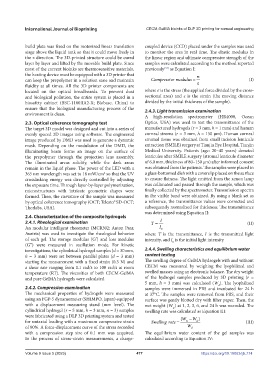Page 485 - IJB-9-5
P. 485
International Journal of Bioprinting CECM-GelMA bioinks of DLP 3D printing for corneal engineering
build plate was fixed on the motorized linear translation coupled device (CCD) placed under the samples was used
stage above the liquid tank so that it could move freely in to monitor the area in real time. The elastic modulus in
the z direction. The 3D-printed structure could be cured the linear region and ultimate compressive strength of the
layer by layer and lifted by the movable build plate. Since samples were calculated according to the method reported
most of the current bioinks are thermosensitive materials, previously as Equation I:
[33]
the heating device must be equipped with a 3D printer that
can keep the prepolymer in a solution state and maintain Compressive modulus (I)
fluidity at all times. All the 3D printer components are
located on the optical breadboards. To prevent dust where σ is the stress (the applied force divided by the cross-
and biological pollution, the entire system is placed in a sectional area) and ε is the strain (the moving distance
biosafety cabinet (BSC-1100IIA2-X; Biobase, China) to divided by the initial thickness of the sample).
ensure that the biological manufacturing process of the 2.4.3. Light transmission examination
environment is clean. A high-resolution spectrometer (HR4000, Ocean
2.3. Optical coherence tomography test Optics, USA) was used to test the transmittance of the
The target 3D model was designed and cut into a series of manufactured hydrogels (r = 3 mm, h = 1 mm) and human
evenly spaced 2D images using software. The engineered corneal stroma (r = 3 mm, h = 150 μm). Human corneal
image produced by DMD was used to generate a dynamic stromal tissue was obtained from small incision lenticule
mask. Depending on the modulation of the DMD, the extraction (SMILE) surgery at Tianjin Eye Hospital, Tianjin
illuminating beam forms an image on the surface of Medical University. Patients (age: 20–40 years) donated
the prepolymer through the projection lens assembly. lenticules after SMILE surgery (stromal lenticule diameter
The illuminated areas solidify, while the dark areas of 6.0 mm, thickness of 80–150 μm) after informed consent
remain in the liquid phase. The power of the LED with a was obtained from the patients. The samples were placed in
365 nm wavelength was set to 18 mW/cm so that the UV a glass-bottomed dish with a coverslip placed on the surface
2
crosslinking energy was directly controlled by adjusting to ensure flatness. The light emitted from the xenon lamp
the exposure time. Through layer-by-layer polymerization, was collimated and passed through the sample, which was
microstructures with intricate geometric shapes were finally collected by the spectrometer. Transmission spectra
formed. Then, the curvature of the sample was measured in the visible band were obtained. By using a blank set as
by optical coherence tomography (OCT; Telesto® SD-OCT; a reference, the transmittance values were corrected and
Thorlabs, USA). subsequently normalized for thickness. The transmittance
was determined using Equation II:
2.4. Characterization of the composite hydrogels
2.4.1. Rheological examination T = I (II)
An modular intelligent rheometer (MCR302; Anton Paar, I 0
Austria) was used to investigate the rheological behavior where T is the transmittance, I is the transmitted light
of each gel. The storage modulus (G¢) and loss modulus intensity, and I is the initial light intensity.
0
(G²) were measured in oscillation mode. For kinetic
investigations, the cylindrical hydrogel samples (d = 30 mm, 2.4.4. Swelling characteristics and equilibrium water
h = 3 mm) were set between parallel plates (d = 3 mm) content testing
starting the measurement with a fixed strain (0.3 N) and The swelling degree of GelMA hydrogels with and without
a shear rate ranging from 0.1 rad/s to 100 rad/s at room CECM was measured by weighing the lyophilized and
temperature (RT). The viscosities of both CECM-GelMA swelled masses using an electronic balance. The dry weight
and pure GelMA hydrogels were calculated. of the hydrogel samples produced by 3D printing (r =
5 mm, h = 3 mm) was calculated (W ). The lyophilized
d
2.4.2. Compression examination samples were immersed in PBS and incubated for 24 h
The mechanical properties of hydrogels were measured at 37°C. The samples were removed from PBS, and their
using an FGP-5 dynamometer (SHIMPO, Japan) equipped surface was gently blotted dry with filter paper. Then, the
with a displacement measuring stand (mm level). The wet weight (W ) at 1, 2, 3, 6, and 24 h was recorded. The
w
cylindrical hydrogel (r = 5 mm, h = 3 mm, n = 3) samples swelling rate was calculated as Equation III:
were fabricated using a DLP 3D printing system and tested ( W W )
for uniaxial loading with a maximum compressive strain Swelling rate w d (III)
of 90%. A force‒displacement curve of the stress recorded W d
with a compression step size of 0.1 mm was acquired. The equilibrium water content of the gel samples was
In the process of stress‒strain measurements, a charge- calculated according to Equation IV:
Volume 9 Issue 5 (2023) 477 https://doi.org/10.18063/ijb.774

